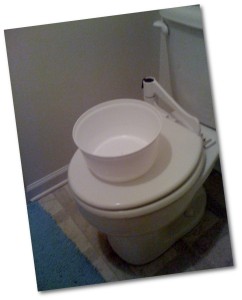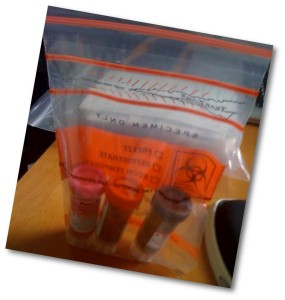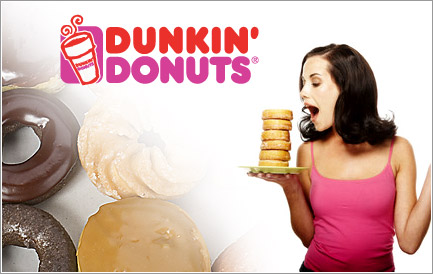Jeff Hansel writes in the Post Bulletin:
I was part of a group that ate at a restaurant. Someone called public health afterward when some of us got a suspected foodborne illness. I  was given a kit with a soft bandage-like catchment to place over the toilet bowl.
was given a kit with a soft bandage-like catchment to place over the toilet bowl.
Did anyone test these on real 40-something guys?
I mean, the catchment (about 2 inches deep, if memory serves) just wasn’t, um, spacious enough.
Somehow I completed the appointed task, guided by complex directions.
And then the affix-the-label-here instructions said something like, “be sure to place bottle in white container.”
What white container?
Eventually, I, for lack of a better phrase, went without it. Public health called. Was I going to provide a sample?
“Yes!” I said proudly. “Mailed it immediately like the directions said!”
“You mailed it … did you take it to the post office?”
“No, I put it in a mailbox.”
This was winter (several years ago). Who knew samples must be kept warm during transport?
“I’m not sure how we’ll handle this…” the epidemiologist said.
It’s my understanding that a team from public health descended like a swarm of angry killer bees and extracted my No. 2 from the U.S. Postal  Service mailbox by the Government Center while holding a postal carrier under threat of torture.
Service mailbox by the Government Center while holding a postal carrier under threat of torture.
Perhaps it wasn’t quite that dramatic.
Regardless, within days of eating at one of our successful local restaurants, I had produced, collected, prepared, deposited and sealed No. 2 in a biohazard container safe enough to be mailed, but intended to be kept at room temperature.
The test came back positive for Clostridium, a common cause of foodborne illness.
I slept on my bathroom floor, suffering from a violent illness I’ll spare you the details of. Let’s just say I eventually looked eerily similar to a haggard purple minion from the movie “Despicable Me 2.”
Half my restaurant lunchmates got sick. They were the ones who drank diet soda. Half didn’t drink soda, and they didn’t get sick.
So I suspect that customers or servers stuck their bare hands in the ice bin. That’s breaking rule No. 1 — and it led to No. 2 on ice.
 “The fridges and freezers were found to be unclean. The fruits which were many days old had fungus on them. At the hotel, we found rats running around in the kitchen. Also, it did not have proper arrangements for waste disposal,” said an official.
“The fridges and freezers were found to be unclean. The fruits which were many days old had fungus on them. At the hotel, we found rats running around in the kitchen. Also, it did not have proper arrangements for waste disposal,” said an official.



 sightseeing, and left unimpressed.
sightseeing, and left unimpressed. are inspecting a large, well-known restaurant or a small mom-and-pop operation. Although it may seem like a blanket approach, it is our job to make sure that anyone selling food items — and ice is considered food — is taking the proper steps to avoid contamination."
are inspecting a large, well-known restaurant or a small mom-and-pop operation. Although it may seem like a blanket approach, it is our job to make sure that anyone selling food items — and ice is considered food — is taking the proper steps to avoid contamination." exposed to hepatitis A by an infected employee.
exposed to hepatitis A by an infected employee.